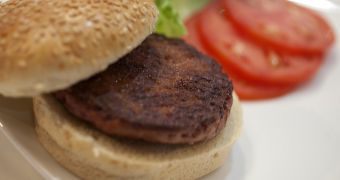The world's first lab-grown burger has been cooked and eaten. While the taste, according to the two volunteers that had the first bites, isn't all that great, it marks a very major milestone in the quest for a more sustainable food source.
Researchers have been trying to find a way to grow meat in a lab, bypassing the messy business of growing and killing an animal for the food.
Lab-grown meat solves several problems: it uses half as much energy as growing a cow, only emits four percent of the greenhouse gas emissions, and only uses one percent of the space needed by a cow. Of course, it also means that no animal suffers just so we can eat our burgers.
There's still some way to go before you'll be eating artificially grown meat at McDonalds, as this first burger cost more than $330,000 (€250,000) to make.
20,000 strands of meat were grown to make the burger. Stem cells collected from a real cow were grown into strips about a centimeter long and a few millimeters thick.
Anything bigger than that and the cells would die off as nutrients won't be able to reach them all without a circulatory system. That's actually the next big step in the research.
Without blood, the cultured meat is quite pale and unappealing. Red beet juice and saffron were used in this first burger to add some color to the meat. Other ingredients, such as egg powder, breadcrumbs, and salt, were added to give it some flavor.
Even so, the taste was off according to the first people to try it. Without any fat or any of the other things normally found in beef, the lab-grown burger wasn't very tasty. That's the biggest hurdle facing cultured meat.
Technology will eventually enable researchers to grow the meat in large quantities cheaply enough to compete with conventional farm grown beef, but getting people to eat the lab meat is going to be a big challenge, especially if it doesn't taste as good as the regular kind.

 14 DAY TRIAL //
14 DAY TRIAL // 